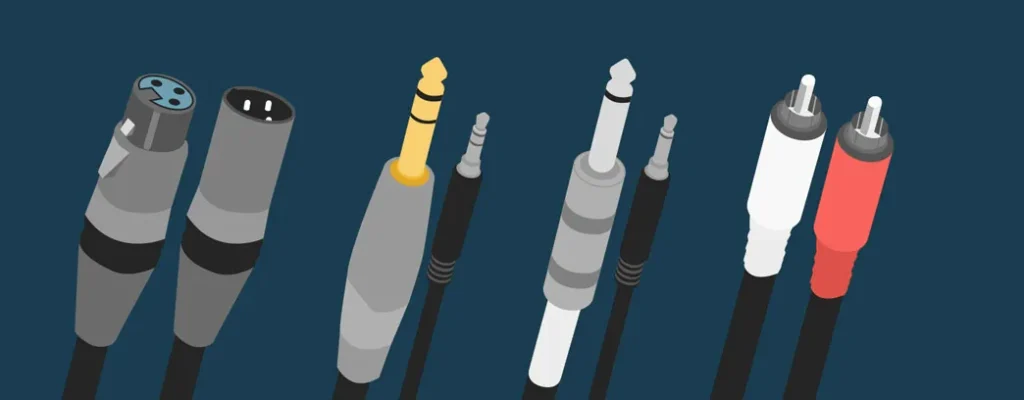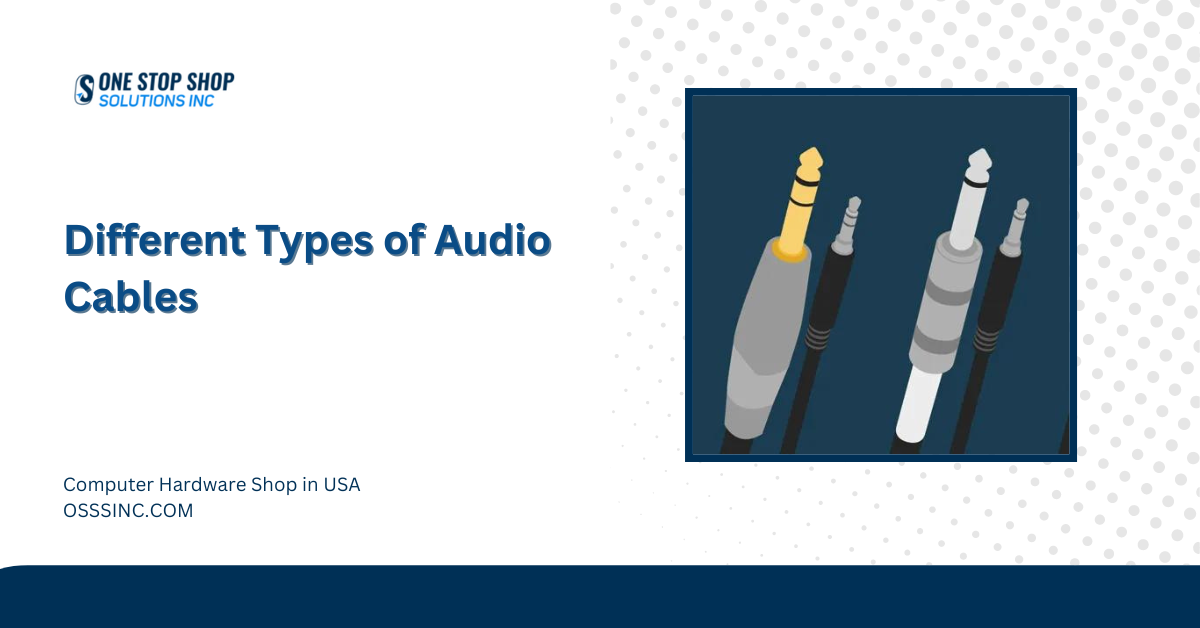Different Types of Audio Cables For Computer Leave a comment
Audio cables play an important role in the transmission of sound signals between audio devices.
Audio cables are only a subset of the larger category of computer cables, which includes a wide range of cables used for a variety of reasons such as data transfer, power supply, and audio/visual transmission.
In this guide, we will explore computer cables, with a concentration on types of audio cables. We’ll look at the various types of audio cables, their characteristics and applications.
Whether you’re a casual listener, or a professional audio engineer, this article will help you confidently and clearly navigate the world of computer audio cables.

What is an Audio Cable?
An audio cable is a sort of electrical cable that transfers sound signals from one audio device to another. These cables can transmit analog or digital signals and come in a variety of configurations, each tailored to specific types of audio equipment and interfaces. Choosing the right audio cable for pc can enhance your listening experience.
What are the Different Types of Audio Cables?
1- TS Cables
What is TS cable?
TS (Tip-Sleeve) cables are the most basic sort of audio cable, commonly used in mono applications. They have a single conductor (the tip) and a ground (the sleeve). This unbalanced cable is commonly used with electric guitars, mono instruments, and some line-level connections.
The simple form of TS cables makes them easy to use, but they are prone to noise and interference, making them unsuitable for lengthy cable runs or settings with severe electrical interference. Despite these disadvantages, TS cables remain popular due to their simplicity and efficacy in specialized applications.
2- TRS Cables
What is TRS cable?
TRS (Tip-Ring-Sleeve) cables are versatile, capable of handling both stereo and balanced mono audio. These are the best audio cables for computers.
They have three conductors:
Tip, Ring, and Sleeve, which represent the left audio channel, right audio channel, and ground, respectively.
TRS cables are widely used for stereo headphones, audio interfaces, and balanced microphone connections. Their balanced nature reduces noise and interference, resulting in crisper music. To avoid connection problems, it is necessary to distinguish between TRS and TS cables.
3- XLR Cables
What is XLR cables?
XLR cables are considered the gold standard in professional audio installations. These cables are known for their longevity and dependability. They have three pins for positive, negative, and ground signals, which aids in producing balanced audio connections that reduce noise and interference.
XLR cables are widely used with microphones, professional audio equipment, and PA systems. The tight locking mechanism offers a sturdy connection, making them suitable for live performances and studio recordings. While they are thicker than other cables, their greater performance makes them suitable for use in professional settings.
4- RCA Cables
What is RCA cables?
RCA cables are analog cables that are widely used for both audio and video applications. RCA cables, identifiable by their color-coded connections (red for right audio, white or black for left audio, and sometimes yellow for composite video), have long been a fixture of household audio and older video equipment.
They provide dependable connections, but are limited to stereo sound and may suffer from signal deterioration over extended distances. Despite the proliferation of digital alternatives, RCA cables are still widely used in home audio systems and turntables.
5- MIDI Cables
What is MIDI cable?
MIDI (Musical Instrument Digital Interface) cables are important for digital music production. They are used to link musical instruments, computers, and other devices in order to send MIDI data, which contains musical performance information rather than audio signals.
MIDI cables include a 5-pin connector and enable the synchronization of several devices, making them essential for sophisticated music production installations. Although USB MIDI connections are becoming more ubiquitous, traditional MIDI cables are still regarded for their dependability and minimal latency in professional music contexts.
6- Speaker Cables / Banana Plugs
What is speaker cable?
Speaker Cables and Banana Plugs are used to connect amplifiers to speakers, resulting in reliable and high-quality audio connections. Speaker cables can be terminated with bare wires, spade connectors, or banana plugs, the latter being a more secure and practical option.
These cables are essential in both household audio systems and professional audio setups, as they facilitate the transmission of audio signals to passive speakers. High-quality speaker cables can improve sound clarity, but banana plugs simplify installation and maintenance.
7- S/PDIF Cables
What is S/PDIF cables?
S/PDIF stands for (Sony/Philips Digital Interface Format) cables carry digital audio signals between devices.
They exist in two varieties:
Coaxial and Optical (TOSLINK). Coaxial S/PDIF cables employ RCA connections and are durable, however they can be susceptible to electrical interference.
Optical S/PDIF cables, on the other hand, use light to convey messages and are resistant to such interference, albeit more delicate. Both types of S/PDIF cables transmit high-quality digital audio and are widely utilized in home theater systems and digital audio interfaces.
8- USB Cables
What is USB cable?
USB (Universal Serial Bus) cables are extremely versatile, being used for power, data transfer, and digital audio. USB connectors come in a variety of types, including USB-A, USB-B, USB-C, and Micro USB.
USB audio cables are commonly used to connect audio interfaces, microphones, headphones, and MIDI controllers to computers. They combine high-quality digital audio with the convenience of power and data transfer in a single cable. However, the many connector types can be confusing, and some devices may require special drivers.
See other Cable types
Conclusion
In conclusion, audio cables are important components that facilitate the smooth transfer of sound between devices. Whether you’re working with analog or digital data, the appropriate cable can make a big difference in the overall audio quality and performance of your setup.
Understanding the various types of audio cables enables you to make informed decisions that improve your listening experience. Each cable type has its own set of characteristics and uses, and the one you choose is determined by your personal requirements and equipment.
High-quality audio cables not only improve sound quality, but they are also durable and compatible with a variety of situations. So choose your audio cable for the computer carefully.
FAQs
1- How do I know if my cable is digital or analog?
Digital cables transmit data in a digital format and often include labels like USB, HDMI, or Optical. Analog cables, like 3.5mm jacks and RCA cables, transmit continuous analog signals.
2- Can audio cables affect latency in my setup?
In analog setups, latency is negligible and primarily a concern in digital audio systems. While the cable itself doesn’t introduce significant latency, the devices processing the digital signal can. High-quality digital cables and efficient audio interfaces help minimize latency.
3- Can I use the same cable for both audio and video signals?
Some cables, like HDMI, can carry both audio and video signals, making them ideal for home theater systems and other AV setups. However, most audio cables are designed specifically for sound and won’t support video signals. Always use the appropriate cable for your specific needs to ensure optimal performance
4- What are the Red and White Audio Cables Called?
RCA analog cables , red for right audio, white or black for left audio, and sometimes yellow for composite video
5- What color are audio cables?
Stereo audio applications use either black and red, grey and red, or white and red.



